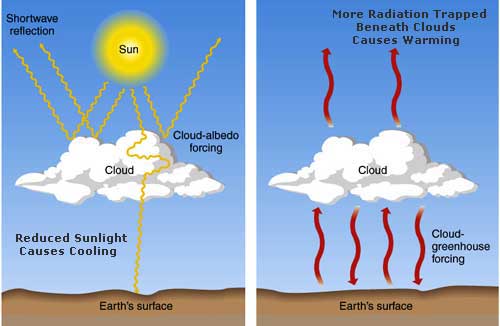THE NATURAL ENVIRONMENT
Geography 101
ToC
HEAT
Albedo
Greenhouse
Balance
Global
Local
Albedo
Reflection of sunlight from solid particles in the atmosphere and from the Earth's surface forms one of the most important controls on Earth's average temperature and on temperature differences between places. The percentage of sunlight reflected from a surface is called its albedo. In general, the greater the albedo, the cooler the surface because less sunlight is absorbed.
|
|
BOX 1 |
Albedo varies widely between surfaces. Has a bright cloud or snow ever made you squint your eyes? They're bright! They have very high albedos of up to 90%. Asphalt and soil, on the other hand, are unlikely to make you shield your eyes because they don't reflect much sunlight, having low albedos in the 5 to 10% range. What would you rather walk on in bare feet, asphalt (albedo 5-10%) or concrete (albedo 15-25%)? The asphalt will usually be hotter, in large part, because more sunlight is absorbed by the surface.
Albedo and absorption are counterparts of the reflective properties of a surface. For example, if the albedo of a surface is 25% then 25% of the sunlight falling on it is reflected back toward the sky and the other 75% is absorbed by the surface.
If you look at the table below, you'll notice that asphalt has a much lower albedo than forest or grass. Because of this, when cities replace natural vegetation, the area usually becomes much hotter. Climatologists call this effect an urban heat island. Other factors also contribute to urban heat islands, but lower albedo is a major influence.
Surface |
|
Albedo |
|
cloud-thin |
|
25-60% |
|
Overall, Earth's mix of cloudy skies and exposed surfaces reflects about 32% of sunlight directly back to space, i.e., the planetary albedo is 32%. (Why do you think you can see a faint new moon? Reflected "Earthlight.") This makes Earth unusual in the solar system. Other worlds are either completely covered with clouds, like Venus with an albedo of 75%, or have no clouds at all, like the Moon with an albedo of 7%. This circumstance means that slight changes in cloud cover can have a major impact on the amount of energy Earth absorbs from the Sun, and, therefore, on the planet's overall temperature.
Effect of Clouds on Planetary Temperature
The relationship between cloud cover and Earth's climate is quite complex and a major unknown in studies of climate change. On one hand, more cloud cover causes higher albedo and less sunlight absorbed by the Earth, causing cooling. On the other hand, more cloud cover means less radiation from the surface escapes to space, causing warming. These competing effects are illustrated below. In general, most scientists believe that an increase in thin cloud cover would cause warming because thin clouds are very good at trapping surface radiation, but have a relatively low albedo. An increase in thick cloud cover, however, would greatly increase Earth's albedo and cause overall cooling. The process of "trapping radiation," called the Greenhouse effect, is discussed in detail in the next chapter.
